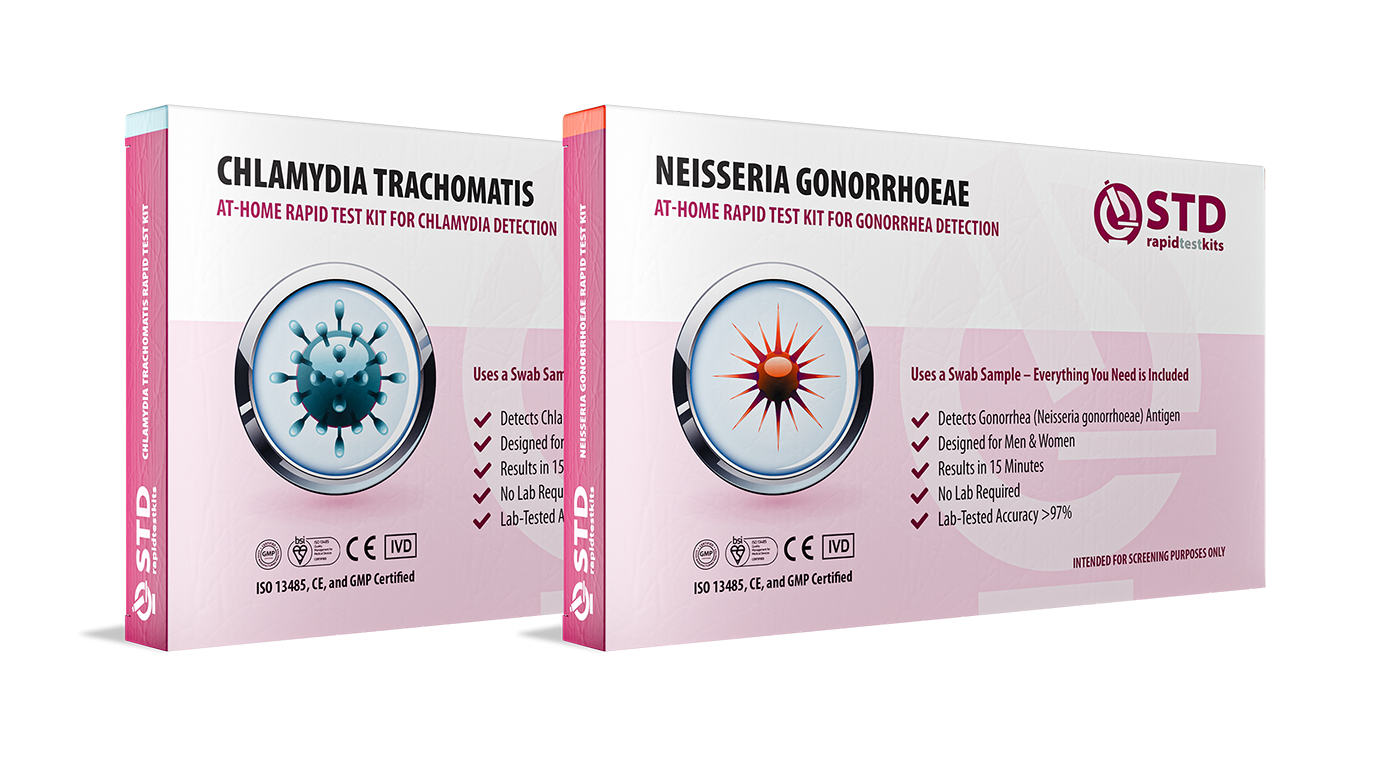STD in the Throat? These Are the Symptoms You Shouldn’t Ignore
What Are Chlamydia and Gonorrhea?
Chlamydia is caused by the bacterium Chlamydia trachomatis. It’s the most commonly reported STD in the United States. Gonorrhea, on the other hand, is caused by Neisseria gonorrhoeae, a different bacterial strain that has increasingly shown signs of antibiotic resistance.
Both infections are transmitted through vaginal, anal, or oral sex. They’re notorious for being "silent," especially in early stages, and can be passed to partners even when no symptoms are present.

People are also looking for: Is That a Pimple or an STD? Decoding Vaginal Bumps
Symptoms: How Do They Show Up (If They Do)?
Most people with Chlamydia or Gonorrhea won’t notice symptoms right away. But when they do show up, here’s what they tend to look like, and how you might tell them apart:
Chlamydia Symptoms
- Discharge: Thin, milky, or mucus-like from the penis or vagina
- Pain during urination: Burning sensation, especially in the urethra
- Pain during sex: More common in people with vaginas
- Lower abdominal pain: Possible sign of spreading infection
Gonorrhea Symptoms
- Discharge: Thick, yellow-green, or pus-like (especially in men)
- Frequent urination: With pain or urgency
- Rectal symptoms: Pain, discharge, or bleeding after anal sex
- Sore throat: From oral transmission (often overlooked)
Still, symptom spotting is never enough. According to the CDC, up to 70% of Chlamydia cases and 50% of Gonorrhea cases in women are completely asymptomatic. Testing is the only way to know for sure.
How Are They Diagnosed?
Both infections are typically diagnosed through a nucleic acid amplification test (NAAT), which detects genetic material from the bacteria in a urine sample, vaginal swab, throat swab, or rectal swab depending on your sexual practices.
You don’t need a pelvic exam or invasive procedures to get tested. At-home kits use simple urine collection or swabs you can do yourself, without a trip to the clinic or a conversation you’re not ready for.
If you test positive for one, your provider will often treat you for both. That’s because co-infection is so common that standard treatment protocols often assume it by default.
Check Your STD Status in Minutes
Test at Home with RemediumChlamydia & Gonorrhea Test

 For Men & Women
For Men & Women Results in Minutes
Results in Minutes No Lab Needed
No Lab Needed Private & Discreet
Private & DiscreetOrder Now $49.00 $98.00
For all 2 tests
Treatment: Are They Cured the Same Way?
Nope. And that matters more than you think.
Chlamydia is typically treated with a one-week course of doxycycline. In some cases, azithromycin (a single dose) is used, though it’s less effective now due to resistance trends.
Gonorrhea, on the other hand, requires a stronger approach. Current guidelines recommend a one-time intramuscular injection of ceftriaxone, often combined with oral doxycycline if a chlamydia co-infection is suspected.
Why injectables? Because Gonorrhea has become notoriously resistant to many oral antibiotics. This has led to public health warnings and growing concern about a potential “super gonorrhea” strain.
The bottom line? Both infections are curable, but only with the right antibiotics at the right time. That’s why accurate diagnosis is so important.
What Happens If You Don't Treat It?
Short answer: things get serious, especially for people with vaginas. Untreated Chlamydia or Gonorrhea doesn’t just go away on its own. It climbs upward into the reproductive tract, causing scarring, inflammation, and lasting damage.
Complications of Chlamydia
- Pelvic inflammatory disease (PID): Can lead to infertility, ectopic pregnancy, and chronic pelvic pain
- Increased HIV risk: Due to compromised mucosal tissue
- Reactive arthritis: Rare, but possible in both men and women
Complications of Gonorrhea
- Disseminated gonococcal infection (DGI): A rare but dangerous condition that spreads through the bloodstream
- Eye infections in newborns: If untreated during pregnancy
- PID and infertility: Similar to chlamydia, especially when co-infected
According to the CDC, up to 10–15% of untreated Chlamydia cases in women develop PID, and Gonorrhea isn’t far behind. That’s why regular testing is more than just a good idea, it’s a sexual health essential.

People are also looking for: What if I’ve never had symptoms, can I still have herpes?
How to Prevent Chlamydia and Gonorrhea
You’ve probably heard this before, but condoms and communication are your two best friends when it comes to STD prevention. Still, let’s be more specific:
- Use condoms consistently: That means vaginal, anal, and oral sex, not just "when it feels risky."
- Get tested regularly: Especially if you’re under 25, have multiple partners, or have a new partner
- Talk before you hook up: Ask about recent tests, symptoms, and exclusive agreements, awkward, yes, but crucial
- Don’t assume you’re safe because you're in a relationship: Many infections happen within long-term monogamy due to lack of screening
And let’s not forget: infections like Gonorrhea can live in the throat and rectum without symptoms. That means oral and anal sex can still transmit them, even when things "look fine."
How These Infections Impact Fertility and Pregnancy
One of the scariest things about Chlamydia and Gonorrhea is that they can quietly damage reproductive organs before symptoms ever appear. In people with uteruses, that means fallopian tube scarring, blocked eggs, and increased risk of miscarriage or ectopic pregnancy.
In men, untreated Gonorrhea and Chlamydia can cause epididymitis, a painful condition that affects the tubes behind the testicles and may lead to infertility.
Pregnant? Testing is essential. Both infections can be passed to the baby during childbirth, causing eye infections, pneumonia, or even life-threatening complications. The good news? Treatment during pregnancy is safe and effective. But only if you know to get tested.
How Often Should You Get Tested?
Here's a quick cheat sheet based on CDC recommendations:
- Sexually active women under 25: Test for Chlamydia and Gonorrhea yearly
- Women 25+ with new or multiple partners: Yearly testing is still advised
- Men who have sex with men (MSM): Test every 3–6 months depending on risk
- Anyone starting a new relationship: Get screened before going condom-free
And remember, symptom-free does not mean infection-free. Silent STDs are still contagious and damaging under the surface.
Check Your STD Status in Minutes
Test at Home with Remedium6-in-1 STD Rapid Test Kit

 For Men & Women
For Men & Women Results in Minutes
Results in Minutes No Lab Needed
No Lab Needed Private & Discreet
Private & DiscreetOrder Now $119.00 $294.00
For all 6 tests
Can You Have Both at the Same Time?
Absolutely, and a lot of people do. According to the CDC, co-infection with Chlamydia and Gonorrhea is common, especially in young adults and those with multiple partners. That’s because the two bacteria often circulate in the same sexual networks and are passed through the same kinds of contact.
If your provider suspects one, they’ll almost always test for both. And if you test positive for one, standard treatment often covers the other, just in case.
How to Tell Them Apart (Without Guessing)
Truth bomb: You can’t tell them apart by symptoms alone. The discharge, the pain, the burning, it overlaps too much. The only way to know what you’re dealing with is to get tested.
If you’re experiencing:
- Penile or vaginal discharge
- Pain during urination
- Rectal or throat symptoms after sex
- Unusual bleeding or spotting
…then it’s time to check, not guess. Fast, accurate, and judgment-free, that’s what home testing is made for.
FAQs
1. Which is worse: Chlamydia or Gonorrhea?
Both can lead to serious health issues if untreated. Gonorrhea is more antibiotic-resistant, while Chlamydia is more common. Neither should be ignored.
2. Can you get both Chlamydia and Gonorrhea at once?
Yes, co-infection is very common. Testing for both is standard medical practice.
3. How long do symptoms take to show up?
Symptoms usually appear 1–3 weeks after exposure, but many people never show symptoms at all.
4. Is discharge different for each?
Yes. Gonorrhea discharge is often thicker and more pus-like; Chlamydia tends to be thinner or mucus-like.
5. Can men get Chlamydia or Gonorrhea in the throat?
Yes, both infections can live in the throat after oral sex, regardless of gender.
6. Are home tests reliable for Chlamydia and Gonorrhea?
Yes, especially NAAT-based tests like the ones offered by STD Rapid Test Kits. They are 95–99% accurate.
7. Can these infections go away on their own?
No. Without antibiotics, both infections can worsen and spread. Treatment is essential.
8. Can I still get pregnant if I had Chlamydia or Gonorrhea?
Yes, if treated early. But untreated infections can damage fertility over time.
9. What if I test positive more than once?
That means reinfection, not treatment failure. You need to treat again and test your partner.
10. How often should I test?
Annually if sexually active, more often if you have new or multiple partners.
Know the Difference, Protect Your Health
Chlamydia and Gonorrhea may look similar on the surface, but they’re different beasts, and both deserve your attention. Left untreated, they can cause lifelong damage. But with the right tools, treatment, and information, they’re both completely manageable.
Take the guesswork out of your sexual health. Whether you’re experiencing symptoms, just got exposed, or are due for a regular check, the Chlamydia + Gonorrhea Home Test Kit has your back.
Sources
3. Chlamydial and Gonococcal Genital Infections – PubMed










